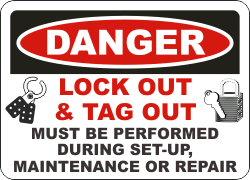Purpose, Scope, and Application
Purpose
The purpose of an energy control program at work, also known as a Lockout/Tagout (LOTO) program, is to protect workers from the unexpected release of hazardous energy during maintenance or servicing of equipment.
Lockout/Tagout Warning Sign

No worker should die or be injured due to the unexpected startup of machines and equipment, or release of stored energy.
Information about the Energy Control Program (ECP) is contained in OSHA 29 CFR 1910.147, Control of Hazardous Energy (Lockout/Tagout). You can open the dropdown windows in the course modules to read the rules within the standard.
The regulation addresses the practices and procedures necessary to disable machinery or equipment, thereby preventing the release of hazardous energy while employees perform servicing and maintenance activities. It also details measures for controlling hazardous energies - electrical, mechanical, hydraulic, pneumatic, chemical, thermal, and other energy sources.
1910.147(a)(3) Purpose.
1910.147(a)(3)(i) This section requires employers to establish a program and utilize procedures for affixing appropriate lockout devices or tagout devices to energy isolating devices, and to otherwise disable machines or equipment to prevent unexpected energization, start-up or release of stored energy in order to prevent injury to employees.
1910.147(a)(3)(ii) When other standards in this part require the use of lockout or tagout, they must be used and supplemented by the procedural and training requirements of this section.
Real Life Scenario
(Source: OSHA)
Knowledge Check Choose the best answer for the question.
1-1. What management action should occur to help prevent fatalities or injuries due to the unexpected startup of equipment or the release of stored energy?
You forgot to answer the question!
